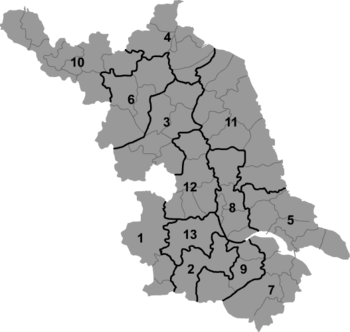Wujin District
| Wujin 武进区 | |
|---|---|
| District | |
 Wujin Location in Jiangsu | |
| Coordinates: 31°37′03″N 119°56′12″E / 31.6175°N 119.9366°ECoordinates: 31°37′03″N 119°56′12″E / 31.6175°N 119.9366°E | |
| Country | People's Republic of China |
| Province | Jiangsu |
| Prefecture-level city | Changzhou |
| Area | |
| • Total | 1,278.22 km2 (493.52 sq mi) |
| Population (2005) | |
| • Total | 951,000 |
| • Density | 740/km2 (1,900/sq mi) |
| Time zone | China Standard (UTC+8) |
| Postal code | 213100 |
Wujin District (simplified Chinese: 武进区; traditional Chinese: 武進區; pinyin: Wǔjìn Qū; Wade–Giles: Wu-chin; postal: Wutsin) is one of districts under the jurisdiction of Changzhou in Jiangsu province of the People's Republic of China. The local language is the Changzhou dialect of Wu Chinese. The postal code for the district is 213100.
Wujin covers an area of 1265 square kilometers. In 2005 the total population was recorded at 951,000 people, 817,000 living in rural areas.[1] This was a decline from the 1.2m inhabitants recorded in 1999.[2] In 2005 Wujin was ranked as 8th in the top 100 best cities and counties in mainland China.[3]
The district is most famous for containing the site of Yancheng[4] (淹城; Yānchéng), the remains of an ancient city from the Spring and Autumn period. The site of the village currently consists of three concentric man-made rivers that once surrounded the village. Around 2007 construction was being finished on shops and a museum in traditional style catering to the many tourists that come to Yancheng each year. With much of the original site now covered in grass with many remaining trees, it is most popular with Changzhou locals as a park. The price of admission to the original site is 20 RMB per person, and the discount ticket price for children ranging from 1.2m to 1.5m (including 1.5m) and the old aging from 60 to 69 years old is 10 RMB per person.[5]
The Oxford International College of Changzhou is also located in Wujin District, serving Chinese and foreign students for kindergarten through high school.
On May 7, 2015, Qishuyan District became the part of Wujin District.[6]
References
- ↑
- ↑ (English) National Population Statistics Materials by County and City - 1999 Period, in China County & City Population 1999, Harvard China Historical GIS
- ↑ 中国百强县网
- ↑ YanCheng official site (Chinese)
- ↑
- ↑ "常州部分区划调整获批:武进区戚墅堰区合并,金坛市撤市设区". thepaper.cn. May 7, 2015. Retrieved May 8, 2015.